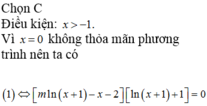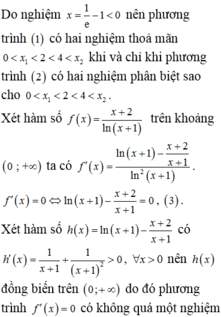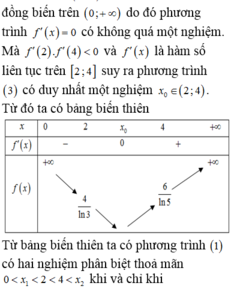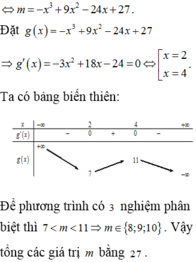Hãy nhập câu hỏi của bạn vào đây, nếu là tài khoản VIP, bạn sẽ được ưu tiên trả lời.

ĐK: x > 0
\(0< x< 1\Leftrightarrow\log_2x< 0\)
Đặt \(t=\log_2x\), pt đã cho trở thành \(t^2-2mt+m+2=0\) (1)
YCBT ↔ pt (1) có hai nghiệm âm phân biệt
\(\Leftrightarrow\begin{cases}\Delta'>0\\S< 0\\P>0\end{cases}\) \(\Leftrightarrow\begin{cases}m^2+3m+2>0\\2m< 0\\m+2>0\end{cases}\) \(\Leftrightarrow-1< m< 0\)

lnx/e là \(\ln (\frac{x}{e})\) hay \(\frac{\ln x}{e}\) hả bạn?

\(ĐK:x>2\\ Pt\Leftrightarrow\log_3\left(x-2\right)^2\left(x-4\right)^2=0\\ \Leftrightarrow\left(x-2\right)^2\left(x-4\right)^2=1\Leftrightarrow\left[{}\begin{matrix}x^2-6x+9=0\\x^2-6x+7=0\end{matrix}\right.\Leftrightarrow\left[{}\begin{matrix}x=3\\3+\sqrt{2}\end{matrix}\right.\)
\(\left(x_1-x_2\right)^2=\left(\sqrt{2}+3-3\right)^2=2\)

Đáp án A.
Ta có ln [x(3x – 2)] = 0 <=> x(3x – 2) = 1 => x = 1 x > 3 2 .

Điều kiện: x> -1
Ta có: 3x2- 6x+ ln( x+1) 3+1=0 hay 3x2- 6x+ 3ln( x+1)+1=0
f(x)=3x2- 6x+ 3ln( x+1) +1=0 ⇒ f ' ( x ) = 6 x - 6 + 3 x + 1
Đạo hàm f’ (x) = 0 khi và chỉ khi (2x- 2) (x+ 1) +1=0
⇔ x = ± 1 2
Từ đây, ta có bảng biến thiên của f(x):

Nhìn vào bảng biến thiên ta sẽ có phương trình đã cho có 3 nghiệm phân biệt.
Chọn C.

Đặt \(2^x=t>0\Rightarrow t^2-mt+10-m=0\) (1)
Để pt đã cho có 2 nghiệm pb thì (1) có 2 nghiệm dương phân biệt
\(\Leftrightarrow\left\{{}\begin{matrix}\Delta=m^2-4\left(10-m\right)>0\\S=m>0\\P=10-m>0\end{matrix}\right.\) \(\Rightarrow\left\{{}\begin{matrix}\left[{}\begin{matrix}m< -2-2\sqrt{11}\\m>-2+2\sqrt{11}\end{matrix}\right.\\0< m< 10\end{matrix}\right.\)
\(\Rightarrow m=\left\{5;6;7;8;9\right\}\) \(\Rightarrow\sum m=35\)

Câu 1:
\(\Leftrightarrow x^2-4x+5+\sqrt{x^2-4x+5}-5=m\)
Đặt \(\sqrt{x^2-4x+5}=\sqrt{\left(x-2\right)^2+1}=a\ge1\)
\(\Rightarrow a^2+a-5=m\) (1)
Xét phương trình: \(x^2-4x+5=a^2\Leftrightarrow x^2-4x+5-a^2=0\)
\(\left\{{}\begin{matrix}x_1+x_2=4\\x_1x_2=5-a^2\end{matrix}\right.\)
\(\Rightarrow\) Nếu \(5-a^2>0\Rightarrow1\le a< \sqrt{5}\) thì pt có 2 nghiệm dương
Nếu \(5-a^2\le0\) \(\Leftrightarrow a\ge\sqrt{5}\) thì pt có 1 nghiệm dương
Vậy để pt đã cho có đúng 2 nghiệm dương thì: (1) có đúng 1 nghiệm thỏa mãn \(1\le a< \sqrt{5}\) hoặc có 2 nghiệm pb \(a_1>a_2\ge\sqrt{5}\)
Xét \(f\left(a\right)=a^2+a-5\) với \(a\ge1\)
\(f'\left(a\right)=0\Rightarrow a=-\frac{1}{2}< 1\Rightarrow f\left(a\right)\) đồng biến \(\forall a\ge1\) \(\Rightarrow y=m\) chỉ có thể cắt \(y=f\left(a\right)\) tại nhiều nhất 1 điểm có hoành độ \(a\ge1\)
\(f\left(1\right)=-3\) ; \(f\left(\sqrt{5}\right)=\sqrt{5}\)
\(\Rightarrow\) Để pt có 2 nghiệm pb đều dương thì \(-3\le m< \sqrt{5}\)
Câu 2:
\(x^2-3x+2\le0\Leftrightarrow1\le x\le2\) (1)
Ta có: \(mx^2+\left(m+1\right)x+m+1\ge0\)
\(\Leftrightarrow m\left(x^2+x+1\right)\ge-x-1\)
\(\Leftrightarrow m\ge\frac{-x-1}{x^2+x+1}=f\left(x\right)\) (2)
Để mọi nghiệm của (1) là nghiệm của (2) \(\Leftrightarrow\left(2\right)\) đúng với mọi \(x\in\left[1;2\right]\)
\(\Rightarrow m\ge\max\limits_{\left[1;2\right]}f\left(x\right)\)
\(f'\left(x\right)=\frac{-\left(x^2+x+1\right)+\left(2x+1\right)\left(x+1\right)}{\left(x^2+x+1\right)^2}=\frac{x^2+2x}{\left(x^2+x+1\right)^2}>0\) \(\forall x\in\left[1;2\right]\)
\(\Rightarrow f\left(x\right)\) đồng biến \(\Rightarrow\max\limits_{\left[1;2\right]}f\left(x\right)=f\left(2\right)=-\frac{3}{7}\)
\(\Rightarrow m\ge-\frac{3}{7}\)






